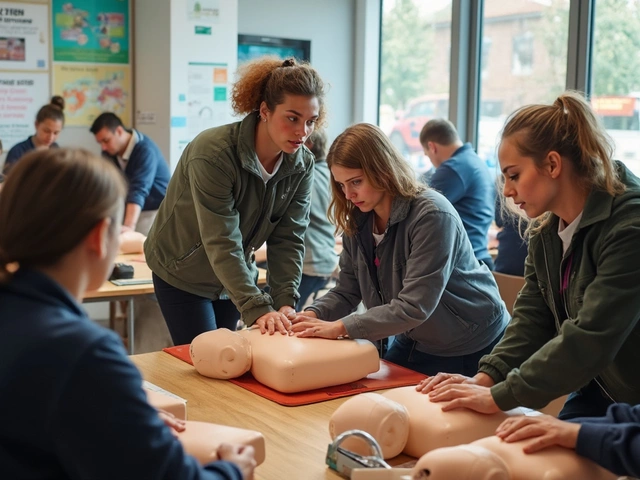NVQ Level 3 Cost Calculator
Estimate Your NVQ Level 3 Costs
Get an accurate estimate of your 2025 NVQ Level 3 qualification costs based on sector, funding options, and location
Ever wondered how much you’ll actually pay to earn a NVQ Level 3 cost in 2025? The price tag can feel like a surprise, especially when you compare it across different providers, sectors, and funding options. This guide pulls back the curtain on tuition, assessment fees, hidden extras, and the money‑saving routes that most learners miss.
What is NVQ Level 3?
NVQ Level 3 is a nationally recognised vocational qualification in England, Wales and Northern Ireland that demonstrates competence at a skilled‑operational level. It sits just below a Level 4 diploma and is often a stepping stone to an apprenticeship or a professional career. The qualification is overseen by Ofqual and is assessed through practical, workplace‑based evidence rather than traditional exams.
Why the Price Varies So Much
Several moving parts colour the final bill:
- Sector of study - Construction, health and safety, IT, and hospitality each have their own fee structures.
- Provider type - Private colleges, community colleges, and online academies charge differently.
- Geographic location - London‑area centres tend to be pricier than those in the Midlands or the North.
- Funding route - Government grants, employer sponsorship, or self‑funded routes dramatically shift the out‑of‑pocket cost.
- Assessment components - Some providers bundle assessment fees; others itemise them separately.
Typical Price Ranges by Sector (2025)
| Sector | Tuition (£) | Assessment (£) | Total (£) | Common Funding Options |
|---|---|---|---|---|
| Construction | 1,200-1,800 | 300-500 | 1,500-2,300 | Employer sponsorship, Apprenticeship levy |
| Health & Safety | 1,000-1,400 | 250-400 | 1,250-1,800 | Government grant, NHS training budget |
| IT & Digital | 1,300-2,000 | 350-600 | 1,650-2,600 | Apprenticeship, Skills Funding Agency |
| Hospitality | 900-1,300 | 200-350 | 1,100-1,650 | Employer sponsorship, Local Enterprise Partnerships |

Funding Options You Might Not Know About
Most learners assume they have to foot the entire bill, but there are several pathways to reduce or even eliminate the cost:
- Apprenticeship routes - If your chosen NVQ aligns with an apprenticeship standard, the Apprenticeship levy and employer contributions can cover up to 100% of tuition and assessment.
- Employer sponsorship - Many employers allocate a training budget. Discuss a sponsorship plan with HR and request a written agreement that spells out payment terms.
- Government grants - The UK government runs the Skills Funding Agency (now part of the Education and Skills Funding Agency). Eligible learners can claim up to £600 towards fees.
- Student loans for adult learners - The Student Loan scheme has been extended to cover many vocational courses. Repayment starts only when your income exceeds £27,000 per year.
- Local authority bursaries - Bodies like Bristol City Council run small‑grant programmes for residents pursuing skills that match local industry needs.
Breaking Down the Total Cost
When you add up the line items, a typical NVQ Level 3 package looks like this:
- Course tuition - The base price for classroom or online instruction.
- Assessment fees - Charges for the final portfolio review, workplace visits, and assessor time.
- Materials & resources - Textbooks, software licences, or safety equipment.
- Administration - Registration, certification, and occasional retake fees.
For a construction‑focused NVQ Level 3, the average breakdown in 2025 is £1,500 tuition, £350 assessment, £150 materials, and £50 admin - totalling roughly £2,050 before any discounts.
Case Study: From £2,300 to £0 - How One Bristol Learner Did It
Sarah, a 28‑year‑old plasterer from Bristol, wanted to boost her credentials. Here’s the step‑by‑step path she took:
- She identified an NVQ Level 3 program offered by a local college with a listed fee of £1,800.
- Sarah’s employer signed a sponsorship agreement worth £1,200, covering most tuition.
- She applied for the Skills Funding Agency grant and received £600, which cleared the remaining assessment fee.
- Materials were supplied by the employer as part of on‑the‑job training, so no extra cost.
Result? Sarah earned her NVQ Level 3 with zero out‑of‑pocket expense.

Tips to Keep Your NVQ Costs Down
- Shop around - Prices can differ by up to 40% between providers.
- Bundle courses - Some colleges offer a discount if you enrol in a Level 2 and Level 3 together.
- Negotiate assessment fees - If you have a strong portfolio, ask if the assessor can reduce the fee.
- Use free online resources for theory - Many reputable sites provide the same content without charge.
- Check for regional schemes - Local enterprise partnerships frequently run temporary vouchers.
Quick Cost Checklist
- Confirm tuition fee with the provider.
- Ask for a detailed breakdown of assessment costs.
- Identify any employer contribution or apprenticeship levy eligibility.
- Apply for government or local authority grants before you start.
- Budget for optional materials and admin fees.
Frequently Asked Questions
How much does an NVQ Level 3 usually cost in England?
Average tuition ranges from £1,000 to £2,000, with assessment fees adding £200-£600. The total typically sits between £1,250 and £2,600, depending on sector and provider.
Can I get my NVQ Level 3 for free?
Yes, if you qualify for full employer sponsorship, an apprenticeship route, or a combination of government grants and bursaries, the out‑of‑pocket cost can be zero.
Do I need to pay for a separate assessment fee?
Most providers charge a distinct assessment fee (typically £250-£500). Some bundle it into the tuition price, so always ask for a full cost breakdown.
What role does Ofqual play in the cost?
Ofqual regulates the standards and quality but does not set fees. Providers set prices within the framework that Ofqual monitors for fairness.
Are online NVQ Level 3 courses cheaper?
Often yes - online delivery removes venue costs and can lower tuition by 10‑30%. However, assessment still requires a workplace visit, which may carry a separate fee.





Write a comment